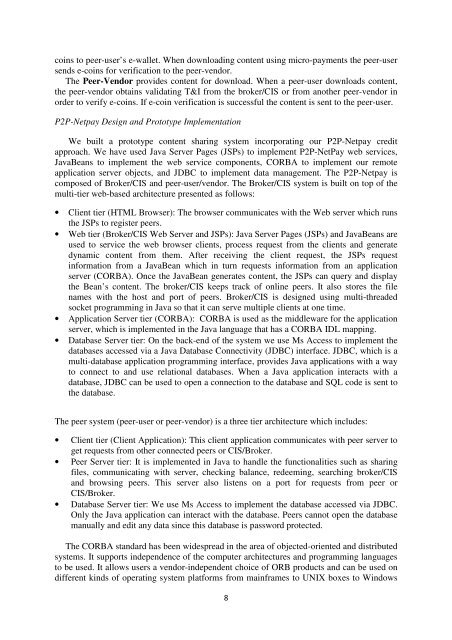View - Faculty of Information and Communication Technologies
View - Faculty of Information and Communication Technologies
View - Faculty of Information and Communication Technologies
Create successful ePaper yourself
Turn your PDF publications into a flip-book with our unique Google optimized e-Paper software.
coins to peer-user’s e-wallet. When downloading content using micro-payments the peer-user<br />
sends e-coins for verification to the peer-vendor.<br />
The Peer-Vendor provides content for download. When a peer-user downloads content,<br />
the peer-vendor obtains validating T&I from the broker/CIS or from another peer-vendor in<br />
order to verify e-coins. If e-coin verification is successful the content is sent to the peer-user.<br />
P2P-Netpay Design <strong>and</strong> Prototype Implementation<br />
We built a prototype content sharing system incorporating our P2P-Netpay credit<br />
approach. We have used Java Server Pages (JSPs) to implement P2P-NetPay web services,<br />
JavaBeans to implement the web service components, CORBA to implement our remote<br />
application server objects, <strong>and</strong> JDBC to implement data management. The P2P-Netpay is<br />
composed <strong>of</strong> Broker/CIS <strong>and</strong> peer-user/vendor. The Broker/CIS system is built on top <strong>of</strong> the<br />
multi-tier web-based architecture presented as follows:<br />
• Client tier (HTML Browser): The browser communicates with the Web server which runs<br />
the JSPs to register peers.<br />
• Web tier (Broker/CIS Web Server <strong>and</strong> JSPs): Java Server Pages (JSPs) <strong>and</strong> JavaBeans are<br />
used to service the web browser clients, process request from the clients <strong>and</strong> generate<br />
dynamic content from them. After receiving the client request, the JSPs request<br />
information from a JavaBean which in turn requests information from an application<br />
server (CORBA). Once the JavaBean generates content, the JSPs can query <strong>and</strong> display<br />
the Bean’s content. The broker/CIS keeps track <strong>of</strong> online peers. It also stores the file<br />
names with the host <strong>and</strong> port <strong>of</strong> peers. Broker/CIS is designed using multi-threaded<br />
socket programming in Java so that it can serve multiple clients at one time.<br />
• Application Server tier (CORBA): CORBA is used as the middleware for the application<br />
server, which is implemented in the Java language that has a CORBA IDL mapping.<br />
• Database Server tier: On the back-end <strong>of</strong> the system we use Ms Access to implement the<br />
databases accessed via a Java Database Connectivity (JDBC) interface. JDBC, which is a<br />
multi-database application programming interface, provides Java applications with a way<br />
to connect to <strong>and</strong> use relational databases. When a Java application interacts with a<br />
database, JDBC can be used to open a connection to the database <strong>and</strong> SQL code is sent to<br />
the database.<br />
The peer system (peer-user or peer-vendor) is a three tier architecture which includes:<br />
• Client tier (Client Application): This client application communicates with peer server to<br />
get requests from other connected peers or CIS/Broker.<br />
• Peer Server tier: It is implemented in Java to h<strong>and</strong>le the functionalities such as sharing<br />
files, communicating with server, checking balance, redeeming, searching broker/CIS<br />
<strong>and</strong> browsing peers. This server also listens on a port for requests from peer or<br />
CIS/Broker.<br />
• Database Server tier: We use Ms Access to implement the database accessed via JDBC.<br />
Only the Java application can interact with the database. Peers cannot open the database<br />
manually <strong>and</strong> edit any data since this database is password protected.<br />
The CORBA st<strong>and</strong>ard has been widespread in the area <strong>of</strong> objected-oriented <strong>and</strong> distributed<br />
systems. It supports independence <strong>of</strong> the computer architectures <strong>and</strong> programming languages<br />
to be used. It allows users a vendor-independent choice <strong>of</strong> ORB products <strong>and</strong> can be used on<br />
different kinds <strong>of</strong> operating system platforms from mainframes to UNIX boxes to Windows<br />
8
















